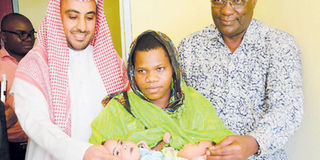What Tanzania can learn from conjoined twins cases

What you need to know:
The incidence of such twins is 1 in 50,000 births, according to a 2017 paper in the journal of Clinical Anatomy, titled ‘Conjoined Twins: From Conception to Separation, a Review’
Dar es Salaam. It is over 25 years since the first set of conjoined twins was reported and separated in Tanzania, yet more occurrences of rare twins have continued making headlines.
Scientists say conjoined twins result from a single fertilised egg that fails to separate completely.
However, scientists are divided on why this happens and such cases remain rare.
The incidence of such twins is 1 in 50,000 births, according to a 2017 paper in the journal of Clinical Anatomy, titled ‘Conjoined Twins: From Conception to Separation, a Review’.
However, because around 60 per cent of those cases are stillborn, the actual incidence rate is closer to 1 in 200,000 births, according to the paper. Almost 70 per cent of these twins are female.
Tanzania was home to some of Africa’s longest-living conjoined twins Maria and Consolata, who died last year at the age of 21. They were against the idea of being surgically separated.
Various reports indicate that separating conjoined twins is a complicated and dangerous procedure, and not all twins -- because of shared organs or other complications—can be separated.
Dr Petronella Ngiloi, a retired paediatric surgeon who, in the early 1990s, witnessed the efforts to separate Tanzania’s early conjoined twins, believes that such incidences have been a turning point in the evolution of medical practice in the country, but much needs to be learnt from them.
A case report she co-authored in 2000 and published in the East African Medical Journal, details the lessons surgeons and other medical experts in Tanzania have been picking from the handling of the conjoined twins’ cases. “…it has been learnt that good team work in the evaluation, separation, and care of conjoined twins is the decisive factor for a successful outcome in most of the successful separations,’’ says the report, titled ‘Final stage surgical treatment of the conjoined twins of Masasi, Tanzania: case report’.
The other factors, the report says, include being able to determine the type of conjoined twins, their complexity, extent of organ sharing and their general condition as well as the expertise and facilities or resources available at the institution where they are born and treated.
Citing technological challenges and lack of expertise, most cases of Tanzania’s conjoined twins who needed to undergo separation have always been referred abroad, save for only two cases which have been separated locally.
In October last year, when Muhimbili National Hospital (MNH) made the second successful separation of conjoined twins after 24 years, experts explained to The Citizen why investment in improved technology and training of more experts would make it much easier for surgeons in the country to separate conjoined twins.
MNH was being cited as an example of a hospital which has invested in imaging technology such as Magnetic Resonance Imaging (MRI), Computer Tomography Scans (CT-Scans) and Ultra Sound as well as Interventional Radiology in managing complex cases, such as the recent separation of conjoined twins.
The hospital’s executive director, Prof Lawrence Museru, said if not for the shortage of specialists who can operate on children, MNH would have been able to handle most of the cases of conjoined twins’ separation.
But, going by Dr Ngiloi’s report in East African Medical Journal, the successful management of conjoined twins locally would have improved if there are strong inter-African collaborations among surgeons and other medical experts.
The report cites an example of the 1998 conjoined twins of Masasi who are the first pygopagus twins (twins joined back to back at the base of the spine and the buttocks), the first type ever reported from Tanzania and how they were managed at the then Muhimbili Medical Centre—now MNH.
The report says,“…successful outcome of the management of the conjoined twins of Masasi is a good illustration of the benefit that can result from the collaboration of Tanzanian and South African surgeons and other medical experts.”
On last year’s October separation of the Kisarawe conjoined twins, the omphalopagus type (joined at the front and at the level of the umbilicus), Dr Ngiloi was keen on sharing her experience of the current times in comparison with the past.
She said: “This [successful operation] could not be done more perfectly like this many years ago. We used to do it somehow blindly.’’
Dr Ngoloi has been in the field for over 30 years now.
“In 1994 when Muhimbili performed its first conjoined twins separation, technology hadn’t advanced as it is today. This partly explains why the past operations weren’t very successful,’’ said Dr Ngiloi, who participated in the 1994 separation of conjoined twins.
“We should be able to perform more complex operations to separate twins, even those whose hearts, heads or chest organs are fused. But this is possible only if we have more specialists in diverse fields of medicine who can operate on children,” she pointed out.
“We need paediatric surgeons to be able to handle the procedures as a team. Currently we are only three. But we also need more heart surgeons for children, neurosurgeons and anaesthesiologists with skills to deal with children. If we have all these, we won’t have to refer patients anymore.”
As the country awaits the return of the Kagera conjoined twins who were separated recently in Saudi Arabia, another set of the twins has been reported in the Lake Zone.
An operation led by Saudi doctor Abdullah Al-Rabeeah ended successfully in separating the Kagera twins Anishia and Melanese at the King Abdullah Children’s Specialist Hospital in Riyadh’s King Abdulaziz Medical City.
The Geita surprise
Last week’s report of the conjoined twins in Geita Region came in a series of stories of such twins that have made headlines in the country in recent years.
In this latest case, medics at Geita Regional Referral Hospital were caught by surprise as they assisted a woman who gave birth to triplets – two of them conjoined. The manner in which the twins were born has exposed technological gaps in Tanzania’s healthcare system.
The woman, Ms Theodora Wilson, had been referred to Geita from Nyang’hwale District Hospital due to severe anaemia. There is scanty information as to whether the medics who referred her, provided the necessary details and the clues that she was actually carrying a multiple pregnancy.
Given the circumstances in which Ms Wilson finally gave birth, it appears there was a communications gap between Nyang’hwale and Geita regarding her state of pregnancy. Otherwise, there shouldn’t have been risk-taking during delivery and the subsequent emergency surgery. The three babies were referred to Bugando Medical Centre in Mwanza Region but died on the way on Wednesday. However, questions have arisen as to whether the woman’s condition was or was not monitored at antenatal clinics in the early stages. There is also a concern as to whether appropriate imaging diagnostic services such as Ultrasound are available in the region.
This raises concerns because researchers have indicated that there are pregnant women and newborns who may die for lack of appropriate monitoring of pregnancy. Current maternal mortality stands at 556 deaths per 100,000 live births, according to the Ministry of Health, Community Development, Gender, Elderly and Children.
In handling referred patients, experts say patients’ documentation is key to avoiding misdiagnosis risks. However, they admit, through experience that there are few circumstances where pregnant mothers with twins would go undetected on Ultrasound. However, Dr Joseph Makuma – who attended Ms Wilson in Geita – revealed how medics were befuddled, apparently not knowing where to start. This is happening in an era when imaging technology, including Ultrasound, can be used to provide clues on the nature of a pregnancy, such as it was highlighted by the Paediatric surgeon, Dr Ngiloi.
“After taking out the first baby,” Dr Makuma explained, “the delivery nurse was surprised that the mother’s tummy was still unusually extended. When I was called in to examine her, I found that there still were two unborn babies...
“Clearly, this was a risky situation – and we had to carry out an emergency Caesarian Section,” the medic revealed.
Going by this scenario, it shows there is a pressing need to boost imaging diagnostic services in lower level healthcare facilities across the country to minimize risks in childbirth. This, in the long-term, will help cut down maternal mortality.




